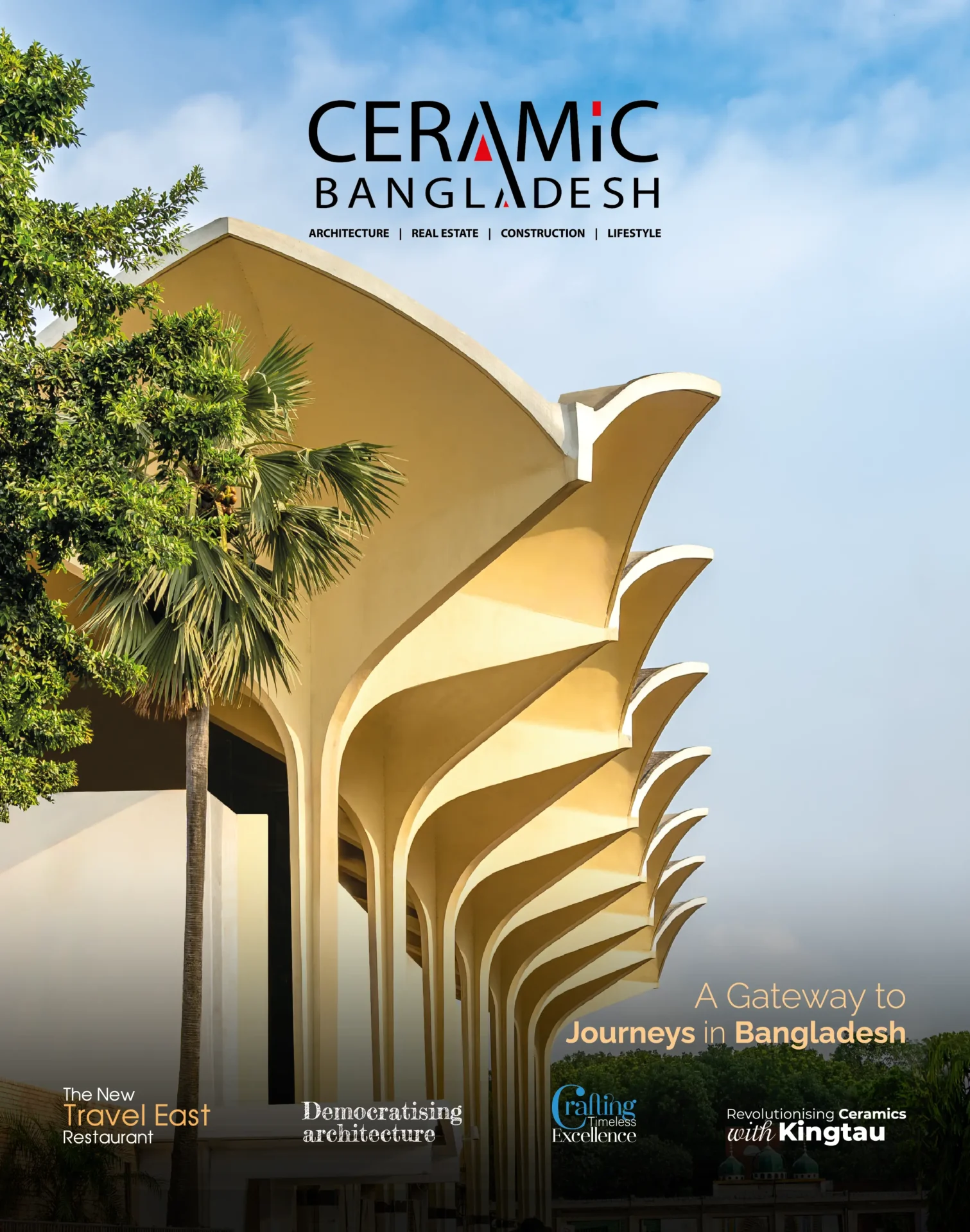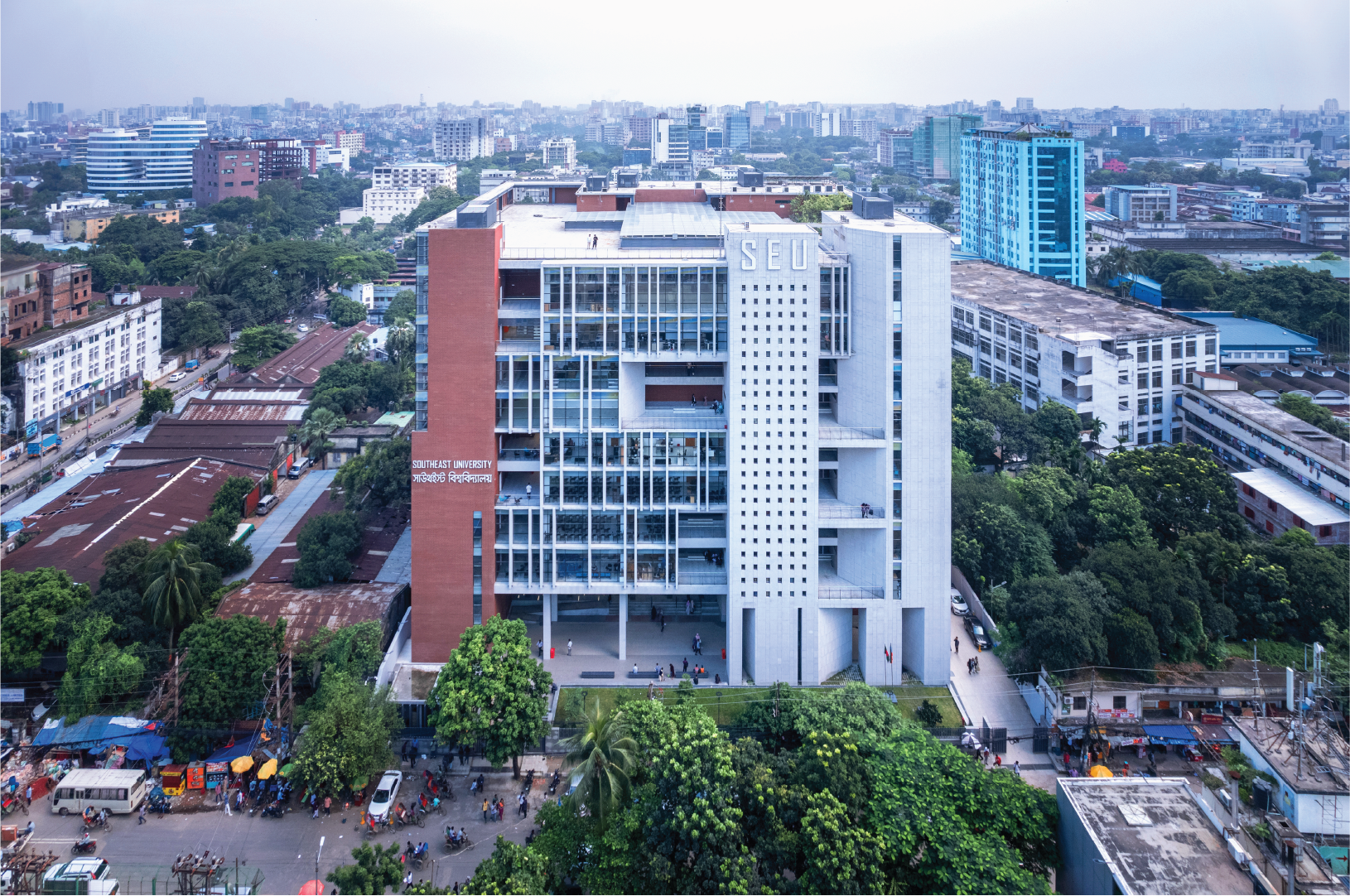

Kamalapur Railway Station, officially known as Dhaka Central Railway Station, stands as a bustling gateway to the vibrant capital city of Dhaka. Nestled in the heart of the city, this vital transportation hub connects travellers to all major cities in Bangladesh. As the largest and busiest railway station in the country, Kamalapur serves as a crucial link, facilitating journeys both near and far.

We are all familiar with the Dhaka University and its grandeur. Even now, when major infrastructures shroud the beautiful campus, its thousands of students still enjoy a little retreat among greeneries in, for example, Muktamancha or Suhrawardi Udyan. The same can also be said for all public universities. It’s on one such campus where BUET alum Khandaker Ashifuzzaman Rajon, Principal Architect of Cubeinside Design Limited, studied architecture. Of course, Rajon’s idea of a campus vastly differs from that of private university students. Thus, when tasked with designing a campus for Southeast University (SEU) well within the hustle-bustle of Dhaka, Rajon had to tumble down all his cards and think of fresh ways to give the students of Southeast University some taste of his own campus-going experience. The project being the permanent campus came with the additional worry of how to design the structure that would inspire students to enrol just looking at the place years, even decades, after its novelty factor has worn off. But before we go further into Rajon’s and the Southeast University permanent campus story, allow us to tell you what it is about all private universities competing to move to their permanent campuses. Competition here is particularly good, as all private universities want a permanent campus that is the most student-friendly while being attractive. UGC, the University Grants Commission, recently stipulated that all private universities, without fail and exception, move to a permanent campus that facilitates students with open space, interactive classrooms, and all the amenities that university students abroad enjoy from a campus. So, that triggered the mass relocation of private universities to actual campuses in place of stuffy buildings. Rajon opened his story with the mandatory 50% open space policy in the rulebook for building a new permanent campus. “The idea of a cubic volume in the centre of the campus came from this rule. I wanted the rest of the structure to look over the open space as the centerpiece of the campus. As a by-product, a central courtyard would help dissipate light and aerate its surroundings, like the classrooms, for example. However, the Board wasn’t initially unanimous about the central open space idea, but it was up on completion that they saw my vision behind this design choice, and this later became everyone’s favorite part of the entire campus,” began the architect. But beyond the Board’s stamp of approval, the campus just had to be completed and made fully functional within a very limited window of time, set by the UGC. If you happen to be a current student of SEU or have even visited the place, you may have taken a moment’s pause and thought of how it was even possible to erect an edifice as such in such a constricted amount of time. This is where the seasoned, but young, architect’s ingenuity just begins. If my memory serves well, I remember seeing in the popular cartoon show “Popeye: The Sailor Man” Popeye stacking floors upon floors of a skyscraper with steel I-beams, all in one shift, of course with the help of his special formula spinach, but steel I-beams were the actual hero that allowed for construction at such mind-boggling speeds. I am not inferring that Rajon got his hands on Popeye’s spinach, but being the well-bred architect that he is, he knew that I-beams would be an ideal instrument in his race against time. He explained how: “All the brick and concrete facades of the entire complex give it the impression of an RCC (reinforced cement concrete) structure, but its basic skeleton is made of I-beams. This bought me time! I-beams, like Lego, just have to be joined together using nuts and bolts without trading modern looks for time or structural integrity, but we did trade off some extra money to be able to complete construction in time.” The mission he had in mind to let light dance around the entire complex with the help of a central open space was a massive success. As the structure was shaping up rather quickly, it was instantly visible that the same campus took on different faces because of the changing sunlight that entered at different angles at different hours of the day. As a creator, the play of light and shadow had Rajon all emotional when he laid eyes upon the outcome. “The place would change its look at the change of each season too,” he said. “A few of my acquaintances who study at SEU find the campus quite photogenic. As climates change, they post photos and reels of different parts of the campus on their social media, and from there, I get to observe, from an onlooker’s perspective, how the most important beneficiaries of the campus—who are the students—are lovingly accepting it and are also low-key boasting it on their socials.” All this is to say that a structure made exclusively out of complex mathematics and engineering can also evoke emotions when made with the human angle in the mix. Ever since the permanent campus opened its doors to students in early 2023, the entire place teems with students in any direction imaginable. Not only is that the proper utilisation of space, but it also points towards the inevitable fact that students love their new campus. Everyone is doing what a student does: going in and out of class, singing, laughing, teasing, playing with classmates between classes, and most importantly, enjoying their newfound freedom in such a capacious facility that can house over 12,000 students at once! The former campus building is in the backyard of the new campus. It will be demolished soon and replaced by a new building to house the School of Engineering. It is to be designed by Cubeinside Design Limited as well. “But looking at the design of the new building and the one we just completed, no one will be able to say that the same architecture firm was behind the drawing board of the second one; it’s that different from the

Cox’s Bazar Rail Station has been built as a modern marvel for travelers. The new ‘green field’ of railway alignment has connected Cox’s Bazar, the top tourist destination and a rapidly developing region in Bangladesh. Finally, the long-term dream of tourists has been fulfilled. On November 11, 2023, Prime Minister Sheikh Hasina inaugurated the 102-kilometre dual gauge single railway line between Cox’s Bazar and Dohazari in Chattogram and the newly built Cox’s Bazar iconic rail station in the shape of oyster shell. The architect of the station, Mohammad Foyez Ullah, principal architect of Volume Zero Limited, took inspiration from the shape of an oyster for its exterior, which symbolises the beach. It is a station with marine atmosphere at first sight. With this, not only has the country’s leading tourist destination become more easily accessible, the entire southeast region is also poised for boosting trade and connectivity. The rail link project, the latest among several such communication-related projects, is part of an elaborate development scheme focused on Cox’s Bazar. Enhanced connectivity will be crucial for transportation of goods to and from Teknaf land port, as well as the growth of local industries including fish, salt, rubber raw materials, forest and agriculture products and dried fruits, according to local business experts. There are nine railway stations on this route, which means the surrounding areas will also see economic transformation. After Cox’s Bazar to Chattogram the stations are followed by Ramu, Islamabad, Dulahajara, Chakaria, Harbang, Lohagara, Satkania and Dohajari. The rail line will be extended to the Myanmar border, and to the planned deep-sea port on Matarbari Island. The extended part will have three stations – Ukhia, Teknaf and Ghumdhum (Bandarban). Cox’s Bazar Station to enhance tourists’ experience Nestled on a 29-acre expanse in Chanderpara, under the Jhilongjha union in Cox’s Bazar Sadar upazila, stands the paradise sighting station, located three km away from the sandy beach, built at a cost of Tk 215 crore. The six-storied building, covering 187,000 square feet area, captivates visitors with its unique exterior. The canopy serves a dual purpose — not only enhancing the station’s aesthetic appeal but also effectively cooling the building, ensuring proper air circulation, and welcoming ample natural light, according to the project engineers. Adding to the visual allure, a variety of coloured lights grace the front of the building, providing an artistic perspective to the station’s entrance. This station is Asia’s first 100 per cent tourist-friendly central air-conditioned multi-storied station. It has all kinds of facilities for tourists. Arrangements have also been made so that tourists can visit Cox’s Bazar in a day and return the same day without hotel accommodation. This railway is perfect Cox’s Bazar as an international tourist hub. It will be helpful to bring foreign tourists. Not only in the winter, tourists will be encouraged to visit Cox’s Bazar throughout the season including monsoon. In the construction of this iconic station, facilities of various modern stations of the world including China, Belgium, England, and Italy have been taken into consideration. A total of 250 engineers and more than 600 people, including 110 foreigners, were working in the entire project. After four years of hard work, the uniquely beautiful railway station building is visible today. On the ground floor, ticket counters, arrival and VIP lounges, ATM booths, Bank and forex service, pharmacy, post office, railway service office, baby care centre, information booth, and luggage lockers. The first floor offers a departure lounge, waiting lounges, display centres, locker room, prayer space, shops, and a cafe. Levels 2 to 5 house a shopping mall and food court, bookshop, five-star overnight stay option with dining, office spaces, restaurants, a multipurpose hall and hotel with recreational space for passengers. The hotel has 39 rooms. The fourth floor is intended to be leased for offices and conferences. Top floor reserved for future use. Travelers arriving at Cox’s Bazar by overnight train can conveniently store their belongings in lockers and explore the beach and other tourist spots during the day before catching a night train back to Chattogram or Dhaka. Tourists can leave their luggage in station lockers while they enjoy their time sightseeing at the beaches and tourist sites. Around 500 tourists will be able to keep their luggage in the station lockers at a time. As a result, tourists would be able to leave Cox’s Bazar without staying at night in hotel. However, they have to pay locker rent for this. The station is equipped with ample amenities, including escalators, lifts, parking area and refresh rooms for men, women, and those with physical disabilities. Accessing any of the three platforms is made easy with a footover bridge connected to escalators, staircases, and a ramp bridge facilitating movement between platforms. The rail station also features separate facilities for women, children, the elderly people. The Cox’s Bazar station has the capacity to transport around 50,000 people each day, as well as facilitate the operation of wagons for transporting fish, dried fish, salt and other items. Work of the project is being completed in two parts with China Railway Engineering Cooperation (CREC) and Toma Construction carrying out the first part from Dohajari to Chakaria and China Civil Engineering Construction Corporation (CCECC) and Max Infrastructure Limited are doing another part from Chakaria to Cox’s Bazar. Additional Deputy Inspector General of Tourist Police Cox’s Bazar region Apel Mahmud said the arrival of tourists in Cox’s Bazar will increase, thanks to the train service. All kinds of preparations have been made for the service and safety of tourists, he added. Passengers say the journey is enjoyable. A crooked rail line has been built through the green field and forest. Sometimes the hills touch, sometimes the eyes will be drawn to the unique beauty of the green village of Bangladesh. A hundred kilometers of railways has completed to see such a scene. Every station is equipped with relay batteries, generator rooms, sewage and waste management facilities, and energy-saving features such as solar panels. Both meter and broad gauge rail


